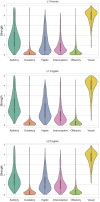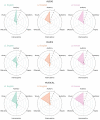The cross-linguistic comparison of perceptual strength norms for Korean, English and L2 English
- PMID: 37538997
- PMCID: PMC10395129
- DOI: 10.3389/fpsyg.2023.1188909
The cross-linguistic comparison of perceptual strength norms for Korean, English and L2 English
Abstract
This study aimed to establish perceptual strength norms for 1,000 words in the languages of Korean, English, and L2 English, in order to investigate the similarity and difference across languages as well as the influence of the environment on semantic processing. The perceptual strength norms, which are a collection of word profiles that summarize how a word is experienced through different sensory modalities including the five common senses and interoception, provide a valuable tool for testing embodiment cognition theory. The results of this study demonstrated that language users had parallel sensory experiences with concepts, and that L2 learners were also able to associate their sensory experiences with linguistic concepts. Additionally, the results highlighted the importance of incorporating interoception as a sensory modality in the development of perceptual strength norms, as it had a negative correlation with both vision and concreteness. This study was the first to establish norms for Korean and L2 English and directly compare languages using the identical and translation-equivalent word list.
Keywords: abstract concept; conceptualization; cross-linguistic; embodiment cognition; grounded cognition; interoception; perceptual strength; second language processing.
Copyright © 2023 Lee and Shin.
Conflict of interest statement
The authors declare that the research was conducted in the absence of any commercial or financial relationships that could be construed as a potential conflict of interest.
Figures






Similar articles
-
Dutch sensory modality norms.Behav Res Methods. 2022 Jun;54(3):1306-1318. doi: 10.3758/s13428-021-01656-9. Epub 2021 Sep 10. Behav Res Methods. 2022. PMID: 34505998 Free PMC article.
-
Perceptual and Interoceptive Strength Norms for 270 French Words.Front Psychol. 2021 Jun 11;12:667271. doi: 10.3389/fpsyg.2021.667271. eCollection 2021. Front Psychol. 2021. PMID: 34177725 Free PMC article.
-
Interoception: the forgotten modality in perceptual grounding of abstract and concrete concepts.Philos Trans R Soc Lond B Biol Sci. 2018 Aug 5;373(1752):20170143. doi: 10.1098/rstb.2017.0143. Philos Trans R Soc Lond B Biol Sci. 2018. PMID: 29915011 Free PMC article.
-
Words as social tools: Language, sociality and inner grounding in abstract concepts.Phys Life Rev. 2019 Jul;29:120-153. doi: 10.1016/j.plrev.2018.12.001. Epub 2018 Dec 6. Phys Life Rev. 2019. PMID: 30573377 Review.
-
A Neuropsychological Perspective on Abstract Word Representation: From Theory to Treatment of Acquired Language Disorders.Curr Neurol Neurosci Rep. 2016 Sep;16(9):79. doi: 10.1007/s11910-016-0683-0. Curr Neurol Neurosci Rep. 2016. PMID: 27443646 Free PMC article. Review.
References
-
- Barros-Loscertales A., González J., Pulvermüller F., Ventura-Campos N., Bustamante J. C., Costumero V., et al. . (2012). Reading salt activates gustatory brain regions: fMRI evidence for semantic grounding in a novel sensory modality. Cerebral Cortex 22, 2554–2563. doi: 10.1093/cercor/bhr324 - DOI - PMC - PubMed
-
- Bates D., Mächler M., Bolker B., Walker S. (2015). Fitting linear mixed-effects models using lme4. J. Stat. Softw. 67, 1–48. doi: 10.48550/arXiv.1406.5823 - DOI
LinkOut - more resources
Full Text Sources

